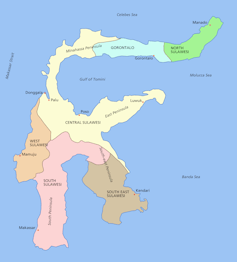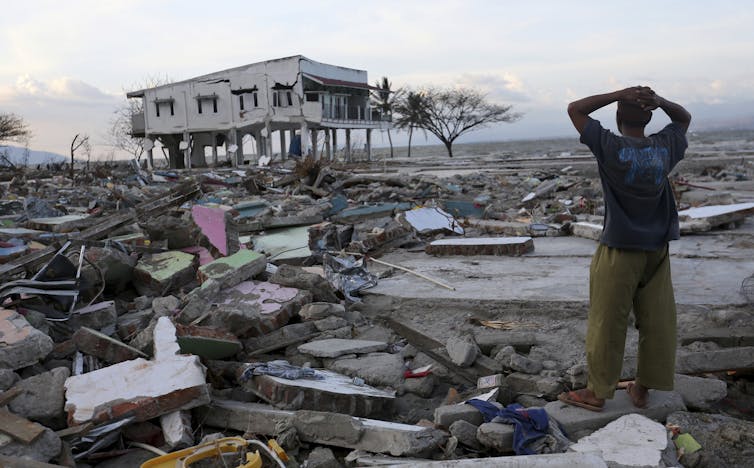An Indonesian city’s destruction reverberates across Sulawesi
- Written by Jennifer Nourse, Associate Professor of Anthropology, University of Richmond
I’ve been visiting the city of Palu in Central Sulawesi[1], a province in Indonesia, for the past 38 years as part of my anthropological fieldwork[2].
So it was particularly harrowing for me to read about the 7.7 magnitude earthquake[3] and tsunami that decimated the city[4] on Sept. 28.
The full scope of the devastation hasn’t come into focus, but thousands have been displaced, died or gone missing[5].
What we do know is that it will take years for Palu, the region’s capital city, to recover and rebuild[6]. But while the devastation might be most visible in Palu, the province’s rural areas could ultimately end up suffering the most.
The hub of Sulawesi
Indonesia, a country made up of 13,000 islands populated by 263 million people[7], has over 300 different ethnic groups in 34 provinces.
Sulawesi Island, once known as the Celebes, has 18 million residents[8] spread over six provinces in an area that’s roughly the size of Florida[9].
 Sulawesi has six provinces, one of which is Central Sulawesi, where Palu is located.
Wikimedia Commons, CC BY-SA[10][11]
Sulawesi has six provinces, one of which is Central Sulawesi, where Palu is located.
Wikimedia Commons, CC BY-SA[10][11]
Because of its unique shape – it looks like a lopsided spider with thin tendrils shooting off in various directions – travel to various parts of the island can be difficult, and many regions are isolated.
When I first arrived in Palu in 1980, it was a quaint city of only 30,000 people. White picket fences surrounded residents’ homes, and colonial-era architecture lined the main thoroughfares. Situated on the shimmering, emerald-colored waters of Palu Bay[12], the city was flanked by a U-shaped curve of steep mountains[13].
It was stunning.
As I searched for a field site, it became quickly apparent that Palu was one of the few cities in the region with paved roads, running water and electricity. Much of this development had occurred since the federal government designated Palu the administrative center for a newly created province of Central Sulawesi in 1978. Using a World Bank loan[14], the federal government was able to fund the construction of roads and government buildings, while expanding the city’s electrical and communication grids.
I eventually decided to focus my anthropological research on the Lauje[15], one of Central Sulawesi’s 32 ethnic groups. The Lauje live in woven bamboo houses deep in the mountains above Tinombo, a region seven hours from Palu by car. For the next two years, I lived in one of these houses studying the Lauje language and conducting fieldwork.
During that period, I only made three or four forays into “modern” Palu. But even back then, it was clear that the city played a vital role in the day-to-day life of the region’s remote villages.
The Palu administrators decided where clinics and schools would be built and how they would be funded and staffed. They helped build and maintain the vital roads and bridges that coastal elites used to access the lucrative ebony, bamboo, cloves, coffee and chocolate farmed by upland peasants.
Steady – but fragile – growth
Over the years, I’ve watched Palu grow. What was once a sleepy little administrative capital where it seemed like everyone knew one another had become, by 2016, a bustling city[16] of 375,000 residents[17] with palatial mansions, gridlocked traffic, rock concerts and shopping malls.
As Central Sulawesi’s capital city, Palu serves not only its residents, but those throughout the province.
It’s where middle-class people living in more rural areas send their kids to university, where they travel to buy computers or automobiles and where they go for serious medical procedures. It’s where administrators from far-flung counties go to attend training workshops, file government reports or request funding for local projects.
While Palu became more prosperous during the 31-year rule of former President Suharto[18], most of the Lauje and the province’s other ethnic communities continued to live in poverty, surviving off subsistence farming.
Change came when President Suharto left office in 1998 and a new democratic government took power.
For decades, Suharto’s family had unfairly controlled the prices[19] of lucrative crops such as coffee, cloves and chocolate[20], pocketing government-imposed costs and fees for themselves.
Now, with fairer costs and prices in place, farmers can profit more from their labor – and can then pay for the books and uniforms required to send their children to middle and high schools.
Meanwhile, more equitable distribution of federal resources funded new schools and health clinics in rural regions. The Palu government also built motorcycle trails that bypassed the rivers, allowing farmers to more easily transport their produce to markets.
In 2017, Central Sulawesi’s economy grew at a rate of 7.14 percent[21]. Much of that has taken place in Palu, but the province’s other regions have slowly been inching out of poverty[22], too.
Life on pause
This fragile economic growth has now been completely upended; the region’s infrastructure is in ruins.
“The air here in Palu smells like rotting corpses,” a friend recently told me over Facebook. “It’s unhealthy and aftershocks still rumble and looters[23] are everywhere.”
With Palu’s bureaucrats, business people and teachers fleeing, no one knows how county governments will be able to function. Life isn’t just on hold for city dwellers; everything in the province, it seems, has come to a standstill.
 A man surveys the damage after the earthquake and tsunami.
AP Photo/Tatan Syuflana[24]
A man surveys the damage after the earthquake and tsunami.
AP Photo/Tatan Syuflana[24]
My friends in several Central Sulawesi communities have told me over Facebook that even though bottled water is scarce, they’re afraid to boil river water still cloudy with debris from the earthquake.
Many rural families receive scholarships to private schools in Palu that train their children to be midwives, pharmacists or medical technicians. What will happen to those already enrolled, whose schools are now shuttered or destroyed?
What will happen to the pregnant women in remote areas who can’t access doctors or midwives because they have all been sent to Palu?
What will happen to the flow of goods that once entered the Port of Palu and were then transported via truck across Central Sulawesi’s mountains?
The rural poor[25] often end up suffering the most after natural disasters[26].
In Central Sulawesi, I fear this will be the case as well.
References
- ^ Central Sulawesi (sulteng.bps.go.id)
- ^ my anthropological fieldwork (scholarship.richmond.edu)
- ^ 7.7 magnitude earthquake (www.thejakartapost.com)
- ^ that decimated the city (www.theatlantic.com)
- ^ but thousands have been displaced, died or gone missing (time.com)
- ^ to recover and rebuild (www.thejakartapost.com)
- ^ 263 million people (www.worldbank.org)
- ^ 18 million residents (sulteng.bps.go.id)
- ^ size of Florida (www.google.com)
- ^ Wikimedia Commons (upload.wikimedia.org)
- ^ CC BY-SA (creativecommons.org)
- ^ emerald-colored waters of Palu Bay (www.flickr.com)
- ^ a U-shaped curve of steep mountains (foursquare.com)
- ^ World Bank loan (www.worldbank.org)
- ^ the Lauje (www.researchgate.net)
- ^ a bustling city (www.thejakartapost.com)
- ^ 375,000 residents (palukota.bps.go.id)
- ^ Suharto (www.nytimes.com)
- ^ had unfairly controlled the prices (www.thejakartapost.com)
- ^ chocolate (sulteng.antaranews.com)
- ^ grew at a rate of 7.14 percent (www.thejakartapost.com)
- ^ been inching out of poverty (www.indonesia-investments.com)
- ^ looters (www.thejakartapost.com)
- ^ AP Photo/Tatan Syuflana (www.apimages.com)
- ^ rural poor (www.theguardian.com)
- ^ natural disasters (www.indonesia-investments.com)
Authors: Jennifer Nourse, Associate Professor of Anthropology, University of Richmond
Read more http://theconversation.com/an-indonesian-citys-destruction-reverberates-across-sulawesi-104470

